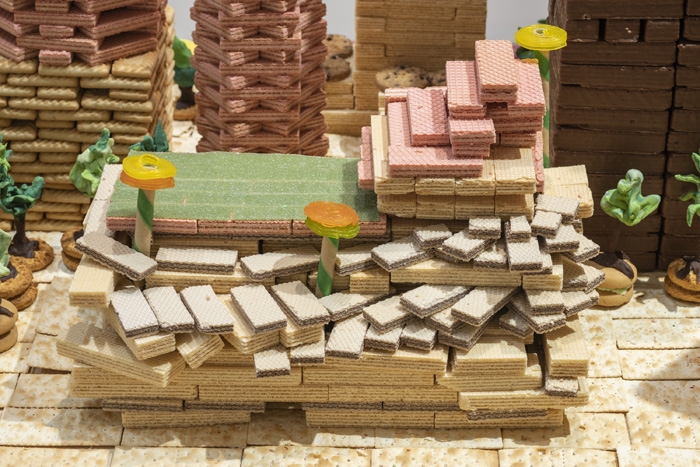“Cool jacket, looks edible!”, a cashier complimented me a few days ago. Edibility is a quality increasingly associated with enticing things and ideas, such as rampant modernisation, development and – apparently – our outfits.
The sugar-coated promises of urban regeneration can be destructive, though. Riding on this admonition, Song Dong’s survey opened at Pace during ‘Frieze week’ with an iteration of the project Eating the City, touring since 2003, which invites the audience to consume a cityscape made of confectionery. Cities are fragile palimpsests, and when the old ways are lost, there is no turning back.
Connoisseur of sweets that I am, I made my way through a hoard of smartphone-wielding art students and collectors in Italian suits to the real delicacy: the sour apple belts – my enjoyment of these went unopposed, since the punters seemed more excited by the thrill of destruction than by gluttony. Few things unleash Eros and Thanatos – if not straight iconoclastic impulses – like a combination of participative art, ravenous Instagram feeds and biscuits within a white-cube environment.
Song’s practice is not all candies and gimmicks, though. The Beijing artist, raised during the Cultural Revolution and graduating in fine art the year of the Tiananmen Square protests, has the ability to comment with candid poetic immediacy on the cultural and political context of his homeland, while also speaking to universal themes. The appeal and limitation of Song’s practice lies in the transposition of quotidian observations into wider meanings, through a generous use of digestible visual metaphors. Some might find this clarity moving, refreshing and effective. Others may find it easy, verging on banal; one doesn’t exclude the other. For example, in the Mandala series (2015), approximative renditions of Buddhist mandalas are traced using seeds and spices, as a celebration of the everyday; Writing Time with Water Beijing (1995), the photographic documentation of a performance in which Song writes the time on asphalt with brush and water, is an attempt to capture a fleeting moment and a remark on the impossibility of defining time; the video Broken Mirror (1999), in which the artist points a camera at a small glass mirror before smashing it with a hammer and revealing the street scene hidden by the glass (including the puzzled expressions of passersby), hints again at the rapid change of the Chinese urban landscape; the Sketch series (2015), consisting of enlarged copies of found shards of porcelain, with the original fragments’ measurements noted in blue glaze, is a prosaic commentary on the beauty of waste and the unprofitable.
In 2005 Song Dong started touring the Waste Not series, a collaboration with his mother in which they organised her entire accumulation of possessions as a series of installations. Simply laid out, folded or piled up were used toothpaste tubes, plastic bags, bottle caps, wrecked furniture and more and more and more. Song Dong sees the wu jin qi yong mentality (translated as ‘waste not’ in English) not just as a characteristic of his mother’s morals and psychology, but of a whole generation of Chinese people, maybe a way to hold on to the past while coping with future uncertainty through the comfort of material hoarding. This ability to comment on social issues starting from the familial and the personal seems watered down in his serialised later works, such as the centrepiece of this exhibition, the installation Same Bed Different Dreams No. 3 (2018), which gives the show its title. Visitors can peep through the shiny reflective surfaces of Song’s signature combinations of salvaged window-panes enclosing found crockery, hanging lights and knickknacks arranged on a double bed. Here, photogenic sentimentality turns the symbolic resistance of a collection of garbage into a polished, collectible artwork. Without the radical tenderness, this sanitised version is unconvincing as the vortex of Song’s first survey in the UK. Same Bed Different Dreams No.3 seems to suck the energy out of the earlier works in order to corroborate its own value, as if the cherry on top had swallowed the whole cake.
Song Dong: Same Bed Different Dreams at Pace Gallery, London 1 October – 5 November
From the December 2019 issue of ArtReview
